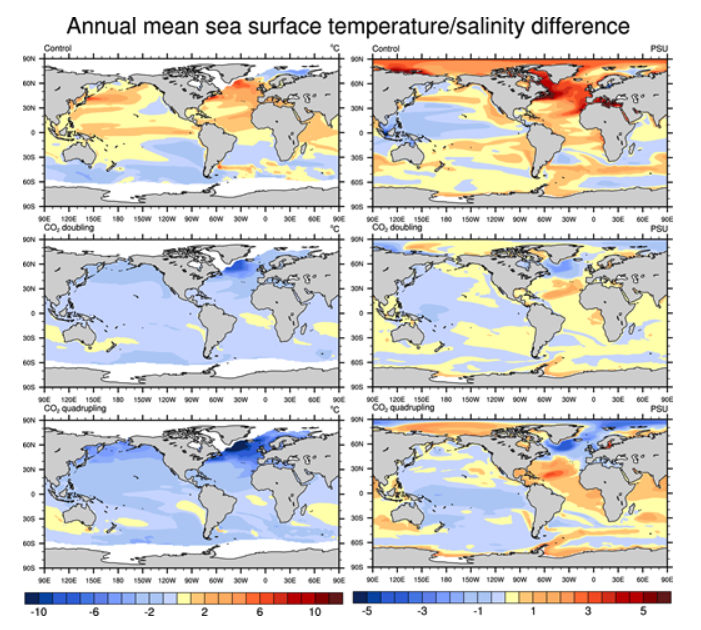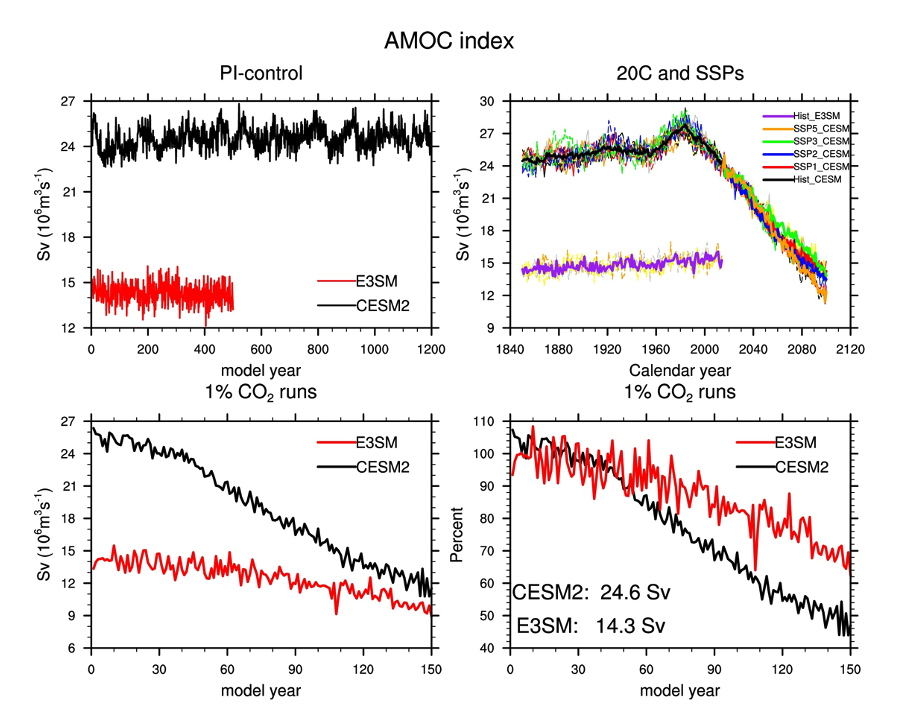Role of AMOC in Two Coupled Models

Annual mean sea surface (left) temperature and (right) salinity difference between CESM2 and E3SM1 in (top) the control run, and in the 1% CO2 run at times of CO2 (middle) doubling and (bottom) quadrupling. The contour interval is 1 K for the left column and 0.5 psu for the right column.
Role of AMOC in Transient Climate Response to Greenhouse Gas Forcing in Two Coupled Models.
The Background
As greenhouse gas concentrations increase, a warmer climate is expected. However, numerous internal climate processes can modulate the primary radiative warming response of the climate system to rising greenhouse gas forcing. This study focuses on the Atlantic Meridional Overturning Circulation (AMOC), one such internal climate process and an important global-scale feature of ocean circulation that serves to transport heat and other scalars. The study addresses the question of how the mean strength of the AMOC can modulate the transient climate response.
The Science

Time evolution of the AMOC index in the (top left) preindustrial control run, (top right) twentieth century and future Shared Socioeconomic Pathways (SSP) runs, (bottom left) 1% CO2 runs, and (bottom right) the percentage changes relative to the control run mean in 1% CO2 runs.
Two coupled climate models were used to study the role of the AMOC in transient climate response – the Community Earth System Model version 2 (CESM2) and the Energy Exascale Earth System Model version 1 (E3SM1). While CESM2 and E3SM1 have very similar equilibrium/effective climate sensitivity, this analysis suggests that a weaker AMOC in E3SM1 contributes, in part, to the higher transient climate response to rising greenhouse gas forcing by permitting faster warming of the upper ocean and a concurrent slower warming of the subsurface ocean. Likewise, the stronger AMOC in CESM2 permitting slower warming of the upper ocean leads in part to a smaller transient climate response. Thus, while the mean strength of AMOC does not affect the equilibrium/effective climate sensitivity, it is likely to play an important role in determining the transient climate response on the centennial time scale.
The Impact
This study suggests that although the mean state of AMOC may not have directly affected the equilibrium climate sensitivity of the global climate system, it does affect the transient climate response to elevated greenhouse gas forcing. Although it is not directly demonstrated, the result hints that the mean state of the AMOC may have also inserted influence on the equilibrium climate sensitivity which needs to be studied further.
Summary

Time evolution of global mean temperature in the (top left) preindustrial control run, (top right) twentieth century and future SSP runs, (bottom left) 1% CO2 runs, and (bottom right) the percentage changes relative to the control run mean in 1% CO2 runs.
Scientists analyzed simulations from two CMIP6 models, CESM2 and E3SM1, focusing on the AMOC and the transient climate response. Analysis shows that the preindustrial mean AMOC in E3SM1 is about 40% weaker than that in CESM2, and the mean AMOC strength in CESM2 agrees with observations very well. The weaker AMOC in E3SM1 is likely due to a number of factors, including the absence of deep convection (North Atlantic Deep Water (NADW) formation) in the Labrador and Irminger Seas. In response to rising greenhouse gas forcing, warming of the surface climate is faster in E3SM1 than in CESM2 due to a much stronger ocean stratification. This stronger upper-ocean stratification in E3SM1 can be attributed partially to a weaker AMOC, which generates a weaker sinking of the upper-ocean water and a weaker upwelling of deep water. As the climate warms, the stronger stratification in E3SM1 increases due to a faster surface warming than the warming in the subsurface ocean. This results in a much faster warming in the upper ocean and less warming in the subsurface ocean in E3SM1 than in CESM2, which demonstrates that the AMOC mean state and its transient response to greenhouse gas forcing can modulate the ocean stratification, and further affect the model transient climate response.
Publication
- Hu, A, L Van Roekel, W Weijer, O Garuba, W Cheng, and B Nadiga. 2020. “Role of AMOC in Transient Climate Response to Greenhouse Gas Forcing in Two Coupled Models.” Journal of Climate 33(14): 5845-5859. https://doi.org/10.1175/jcli-d-19-1027.1.
Funding
- The U.S. Department of Energy Office of Science, Biological and Environmental Research supported this research as part of the Earth System Modeling Program Area, Regional & Global Model Analysis.
Project
Contact
- Aixue Hu
National Center for Atmospheric Research (NCAR)


